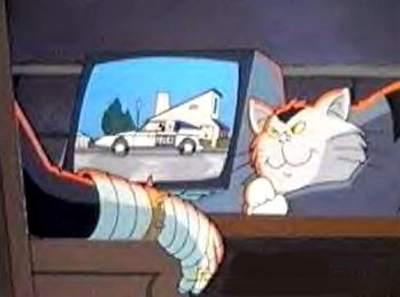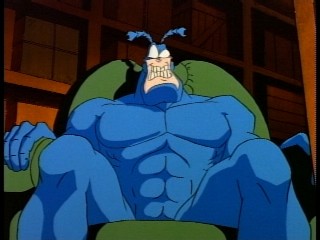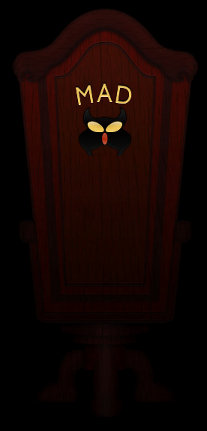Dr Claw’s Chair (Inspector Gadget)
by Fenzel
When I heard about a Think Tank on fictional furniture, I was excited to write about the World’s Most Comfortable Chair from The Tick. It’s a chair so comfortable that it has become a powerful weapon – anyone who sits in it is overwhelmed and incapable of doing anything else. I frequently quote the episode of The Tick (this is the cartoon, ‘natch) in which it appears, when this chair hoists the villain by his own petard: “Maybe I don’t have to conquer the world. Maybe I can just sit in this chair.” It’s a stirring sentiment.
But then I thought about it more, I realized it was less interesting to talk about fictional furniture, and more interesting to talk about furniture in fiction. Well, I didn’t exactly realize it – my Overthinking It colleagues made it clear to me that I was a bit off the mark with my appraisal of the topic.
Very well then. Maybe I have to get up from that super-comfy chair. No matter. Just like 7:30 on a Monday morning. Okay.
So, let’s talk about what makes furniture in fiction interesting. I’ve performed in a lot of stage shows, and I have a good sense for when I think a piece of furniture is accomplishing something interesting narratively or aesthetically and when it is not. When it does accomplish something, and it manages to be aesthetically pleasing, and it manages to be dense on content, compelling, and thrive on reinterpretation and second looks, that’s when I think you’ve got something.
Regular readers of Think Tank may know that I tend to prize elegance as one of my chief aesthetic values. Symbols or works of art that manage to say many things at once without appearing to have too many moving parts always impress me.
Behold:
Dr. Claw’s chair is not unique in its role – there are several other fictional chairs that mainly serve the purpose of ominously obscuring the sitter. For the uninitiated (or the only Matthew Broderick initiated), on the cartoon Inspector Gadget, the back of this chair was usually all you saw of the series primary antagonist Dr. Claw, who ran the fictional criminal organization M.A.D. – well, you also usually saw a KISS-army-style gauntleted hand stroking a fat cat with uncanny coloration. But that dense symbolism is fit for another post.
The thing I love about Dr. Claw’s chair is how backhanded (no pun intended) it is – while it mainly serves to hide the identity of the antagonist, it also tells us almost everything we know or need to know about him. It makes a HUGE statement. The old European styling, the unfinished, heavy wood frame, the emblazoned devil mask and company acronym on the back – this is a chair that brags, people, not a chair that hides. Very ironic, very elegant.
The M.A.D. organization is a pretty nonsensical and comical thing – it’s a super-evil spy organization that doesn’t really do much to effectively hide itself. Its henchmen tend to dress fairly conspicuously, albeit in black. Its schemes are outlandish and seem likely to drift into the public eye fairly easy. The whole gang is borderline flamboyant – the only people who really effectivley keep secrets are Penny and Brain, the bumbling robo-inspector’s niece and dog, respectively.
For the show to work, the symbolism surrounding M.A.D. and Dr. Claw needs to instantly communicate the core irony behind M.A.D. – that it is a flamboyant secret organization that draws heavily on traditional ideas of villainy, but has its own sort of zany spin on things. This wouldn’t really work if the first thing you saw of M.A.D. was just a chair in the darkness. No, it has a crazy devil mask emblazoned on it – no, it has a shape that belongs in a French court or an English gothic romance.

Do you think MAD Cat is named after the organization, or is it the other way around? Is the cat really the one in charge? Sound off in the comments?
Also, note how low-tech the chair appears to be, even though M.A.D. is a pretty high-tech organization. This further strengthens the sense that these people are the enemies of Inspector Gadget, who tends to be pretty sleek and modern with his aesthetic preferences, up to and including his narrow-cut, pale grey trenchcoat.
I’d argue that Dr. Claw’s chair is the real antagonist in Inspector Gadget. It accomplishes more than the Good Doctor ever does, it makes a huge statement – and, you know, it really pulls the room together (See, fictional furniture, rather than furniture in fiction, would have been an interesting topic!).
Want to write in a piece of furniture? Leave a comment below.


Monkey outta nowhere! Fenzel, your reference to the wonderful Tick cartoon warms the cockles of my heart. This has nothing to do with furniture, but have you ever read the original Tick comic books? I read them before I read Watchmen, and I didn’t realize until recently how very many Watchmen references there are in there. A very gentle and loving superhero parody parodying a far more negative superhero deconstruction? How meta!
I have read a bit of the old Tick – but most of my downward spiral of comic self-parody comes from a years-long reading of the ENTIRETY of Cerebus the Aardvark, which literally drove me to the brink of a mental breakdown — to the extent that I actually had to throw away most of my books (I think I kept Jaka’s Story), to avoid looking at them again and becoming phenomenally depressed.
You know what I was really surprised to see? The _American Splendor_ references in the early volumes of _Teenage Mutant Ninja Turtles_ I read recently. My roommate’s girlfriend picked up a compilation of some of the earliest TMNT books from somebody who was throwing them out – and there’s a lot of reverence in there to other early independent comicsp, which of course TMNT surpassed in popularity by orders of magnitude.
Pretty funny that TMNT was name-checking American Splendor ten years before the first TMNT movie – and twenty years before the American Splendor movie.
History works in mysterious ways – especially when you’re dealing with artists who see the world as individuals, rather than the institutional creativity you see out of the corporate titles.
Wait, it’s a devil face on the back of the chair? I always thought it was a cat.
The Dude’s rug from “The Big Lebowski”. It really tied the room together, you know?
I thought about the rug from Lebowski, but then I wondered if a rug really counts as a piece of furniture. It’s more of a home furnishing, no? I think part of the definition of furniture is that it rises vertically from the floor to provide utility.
But then again, as Donny often is, I may be out of my element on this one.
If I’m not stretching it by suggesting a TYPE (and if they aren’t just appliances), I’d say the televisions in the _Toy Story_ movies. Every time a TV shows up, one of the major characters has a pivotal self-identity revelation, one that drives the plot forward and without which no character development would occur; or it gives characters plot-driving clues without which the story would end.
Some other suggestions from the OTI writers that didn’t make the post were:
Arthur’s round table
C.S. Lewis’s wardrobe
Cat in the Hat Credenza
Python’s comfy chair
The bed from Bedknobs and Broomsticks
Chairey from Pee Wee’s Playhouse
The table in Da Vinci’s Last Supper (is it fiction or non-fiction? Somewhere in between?)
All fine choices…but only one of them (sort of) rhymes with “Beretta.”